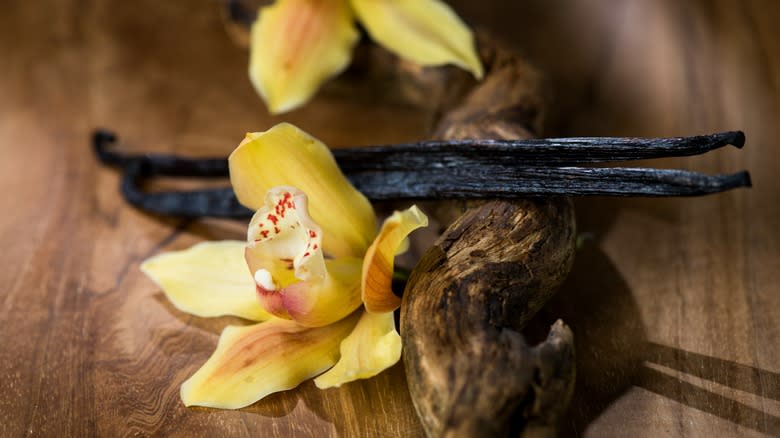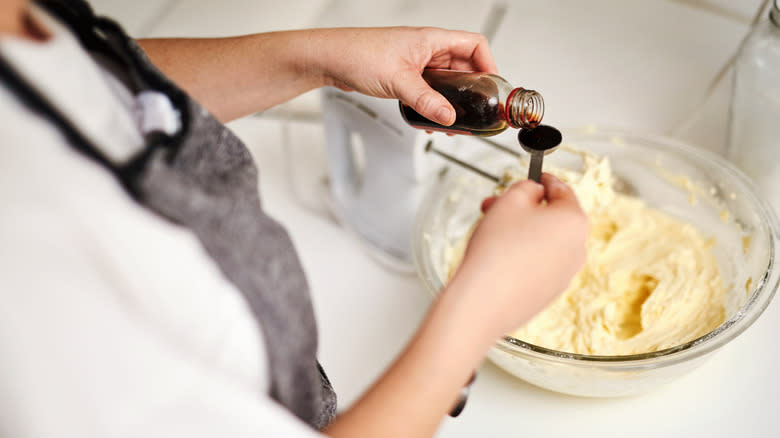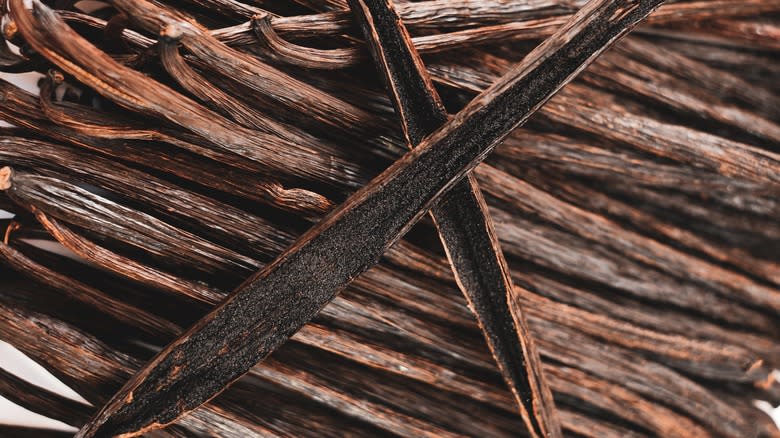Bake Like A Pro By Expanding What Types Of Vanilla You Use

It's a culinary travesty that vanilla, a spice with a complexity of over 250 flavor components, has become a synonym for basic and boring. Baking with vanilla like a pro entails understanding its subtleties and unique character — not just in taste and aroma but also in the form of vanilla used for a given cake, pastry, or dessert.
The two most familiar for home bakers are pods and extract. The vanilla pod, the cured and dried fruit of the vanilla orchid, contains thousands of tiny fragrant seeds, with tons of flavor to be found in the pod — or bean — itself, too. This is a real-deal vanilla, but you should still be aware of what to look for when buying vanilla beans. Shriveled, limp-looking things aren't going to give you great flavor.
Vanilla extract can also have its pitfalls. Good, or natural, vanilla extract is made of vanilla pods soaked in alcohol and water, in order to pull out all those aromatic compounds. In an interview with Eater, Shauna Sever — who wrote "Pure Vanilla: Irresistible Recipes and Essential Techniques" — says, "As long as it has the word 'pure' on it and the label just says vanilla beans and alcohol, you're in business."
Avoid anything imitation or artificial, whose synthetic vanillin flavoring just doesn't cut it in any context. In between these two versions is vanilla bean paste, which, appropriately, combines both vanilla seeds and natural vanilla extract.
Read more: 8 Baking Sheet Mistakes You Want To Avoid
When To Use Each Type Of Vanilla

A good rule of thumb for baking with vanilla like a pro is to splurge when you want vanilla to be the star and take it a bit easier as you dial back its presence in the finished dish.
Vanilla extract is best when the vanilla isn't really being tasted in the final product — think how it goes into all manner of desserts and bakes as a flavor balancer. Here, its complexity is never going to be center stage, so there's no point using an expensive vanilla pod when a small amount of natural extract will do. (Natural vanilla extracts are of such good quality and a comparatively affordable price point that the temptation to make your own vanilla extract is a waste of time and money.)
By contrast, vanilla pods — seed, bean, and all — are essential in things like vanilla ice cream, custard, and even sides like chantilly cream. This isn't just for an explosion of sweet, floral fragrance; the stark contrast of the speckled black seeds on the white or beige is stunning, too. As for the paste, this can be a cost-effective and convenient alternative to pods, ready to go at a moment's notice and not requiring any splitting or scraping to extract its flavor.
Exploring A World Of Vanilla Varieties

You don't have to stop at deciding between vanilla pods, vanilla paste, and vanilla extract when baking with vanilla like a pro. Like any other ingredient from a plant or flower, vanilla is affected by terroir — where those vanilla orchids grew and which species they are has a significant impact on their final flavor.
Most of the world's vanilla comes from Madagascar, so the flavor profile of Madagascan vanilla is probably the one you're most familiar with. This wasn't the result of nature taking its course. Vanilla originated wild in Mexico; British colonizers brought it to Madagascar, where they converted it to a domestic crop. Mexican vanilla has a comparatively chocolatey, resinous, and hefty aroma, which explains its importance to the profile of Mexican hot chocolate, which originated as "xocohotl" in the Aztec civilization.
Meanwhile, Tahitian vanilla is on the other end of the spectrum, with an ethereal, floral, fruity profile that makes for an incredible vanilla ice cream. It has comparatively less vanillin than Mexican and Madagascan vanilla, accounting for the less rounded, almost crisper flavor.
Read the original article on Daily Meal.